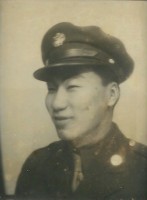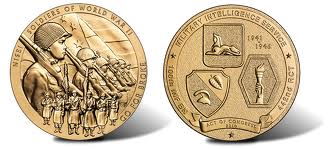
Clarksville, TN – In researching this story, and getting to know the life of George Nishimura, I’ve learned so much about World War II that I have never known before. His personal handwritten account of his life is an amazing recollection of what it was like growing up in a country that came under attack from the Japanese, and how he wanted to “do something” to help the Americans fight back.
George Nishimura served his country in the best way he knew how. He followed orders and did what he was told. The Japanese-American soldiers who volunteered to serve, were treated differently. There was a feeling of apprehension by most Americans, who wondered how can the “Japs” be the good guy and bad?
Wikipedia describes their place in history this way:
The 100th Infantry Battalion relocated to Camp Shelby in Mississippi. Eventually, the 100th was joined by 3,000 volunteers from Hawaii and 800 from the mainland camps. As a regimental combat team (RCT), the 442nd RCT was a self-sufficient fighting formation of three infantry battalions (originally 1st, 2nd, and 3rd Battalions, 442nd Infantry, and later the 100th Infantry Battalion in place of the 1st), the 522nd Field Artillery Battalion, the 232nd Engineer Company, an anti-tank company, cannon company, service company, medical detachment, headquarters companies, and the 206th Army Band.
Although they were permitted to volunteer to fight, Americans of Japanese ancestry were generally forbidden to fight in combat in the Pacific Theater. No such limitations were placed on Americans of German or Italian ancestry who fought against the Axis Powers in the European Theater, mostly due to practicality, as there were many more German and Italian Americans than Japanese–Americans. Many men deemed proficient enough in the Japanese language were approached, or sometimes ordered, to join the Military Intelligence Service (MIS) to serve as translators/interpreters and spies in the Pacific, as well as in the China Burma India Theater. These men were sent to the MIS Language School at Camp Savage, Minnesota to develop their language skills and receive training in military intelligence. While the 442nd trained in Mississippi, the 100th departed for Oran in North Africa to join the forces destined to invade Italy.
Japanese-American soldiers were in a unique situation. They wanted to serve, but the country didn’t quite know what to do about them. Were they friendly? Why did they bomb Pearl Harbor?
A search of the history books, or a “google” of the 442nd and related units will reveal this was an amazing outfit of soldiers who answered the call for whatever their country needed of them.
In battle, history remembers their first contact:
The newly–formed Nisei unit went into battle together on June 26, 1944 at the town of Belvedere. Although the 100th was attached to the 442nd, their actions earned them a separate Presidential Unit Citation. 2nd and 3rd Battalions were the first to engage the enemy, in a fierce firefight. F Company bore the worst fighting. A, B, and C Companies of the 100th were called into combat and advanced east using a covered route to reach the high ground northeast of Belvedere.[4] The enemy did not know that the 100th was flanking the German exit, trapping them in Belvedere. C Company blocked the town’s entrance while A Company blocked the exit. As this was occurring the 442nd’s 2nd Battalion was receiving a heavy barrage by the Germans from inside Belvedere, and the Germans remained unaware of their situation. B Company stayed on the high ground and conducted a surprise attack on the German Battalion’s exposed east flank forcing the Germans to flee and run into C Company which then drove the Germans to A Company.[5]
All three companies went into action boldly facing murderous fire from all types of weapons and tanks and at times fighting without artillery support…. The stubborn desire of the men to close with a numerically superior enemy and the rapidity with which they fought enabled the 100th Infantry Battalion to destroy completely the right flank positions of a German Army….The fortitude and intrepidity displayed by the officers and men of the 100th Infantry Battalion reflects the finest traditions of the Army of the United States.[6] Presidential Unit Citation ReviewThe 442nd, along with its first battalion, the 100th, kept driving the enemy north, engaging in multiple skirmishes until they had passed Sassetta. The battle of Belvedere showed that the 442nd could hold their own but showed them the kind of fighting the 100th had gone through in the prior months. After only a few days of rest, the united 442nd again entered into combat on July 1, taking Cecina and moving towards the Arno River. As the 442nd approached the Arno River, on July 5, 2 Battalion engaged in a hard–fought battle to take Hill 140, while on July 7 the 100th fought for the town of Castellina.
The Military Intelligence Service, and the language officers serving the front line, were a major part of the American success in the war. Documents that would have otherwise never been understood, prisoners of war who needed to be interrogated, and communications that never would have been understood, are the success of soldiers who just wanted to help America win the war.
George Nishimura did his part. He served his country.
The United States House of Representatives passed unanimously on Sept. 23rd, 2010: S-1055 to award the Congressional Gold Medal, the highest civilian award the nation can bestow, collectively to the 100th Infantry Battalion, the 442nd Regimental Combat Team and the Nisei who served in the Military Intelligence Service. The Senate had voted unanimously on Aug. 4th to approve the award. On November 2nd, 2011 a ceremony was held in Washington D.C. to honor these men.
Unfortunately, Mr. Nishimura was not included in this ceremony. The battlefield promotion changed his army serial number and his name was inadvertently dropped from the roles of the 442/MIS. His family was not notified of ceremony and award until 2 days prior. Shortly thereafter, his daughter was able to contact several veterans groups affiliated with the 442nd and he was once again added to their rosters. However, to this date, he remains unrecognized for his service and dedication to his country.
That will change on this date, Friday, February 22nd, 2013, as friends and family will gather to honor George Nishimura for his service and incredible sacrifice. At 4:00pm at F&M Bank’s Franklin Room in downtown Clarksville, George Nishimura will receive a bronze replica of the Congressional Gold Medal he so deserved.
Representatives from the city of Clarksville and Montgomery County, along with State Representative Joe Pitts, Congressman Marsha Blackburn representative Bo Patten, LTC Richard Coyle from the Commanding General’s staff, and Senator Mark Green will be on hand to present Mr. Nishimura his honor.



